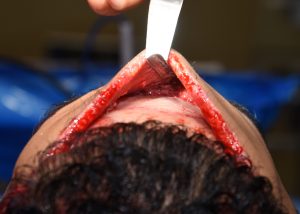
Most transgender brow bone reductions are Type III while Type I and II are more commonly done in cis-females. Given the popularity of these surgeries now done around the world a relevant question is their outcomes both from a complication and satisfaction standpoint.
In the August 2023 issue of the Aesthetic Plastic Surgery Journal an article on this topic was published entitled ‘Facial Gender-Affirming Surgery: Frontal Bossing Surgical Techniques, Outcomes and Safety’. In one hundred (100) consecutive cases the authors report their outcomes in these three forehead feminization type procedures. Complications included hematoma (1), delayed wound healing (6), hair loss along incision line (1), palpable hardware (5) and chronic sinusitis (1). Patient satisfaction was 95%.
Forehead feminization surgery can be seen to be very safe (sinusitis only medical complication) and effective. (95%) Like most aesthetic surgeries its main complications are aesthetic in nature….not that they are not important. Just that they are less problematic to solve and the timing of management is more lenient. Frontal sinusitis and bone flap loss are the most significant complications but are rare.
Interestingly this article refers to what is more commonly known as brow bone protrusion as frontal bossing. Frontal bossing typically refers to various bony enlargements of the forehead that are not related to the frontal sinus. Whereas brow bone enlargements or hypertrophy refers to the lower forehead whose shape is highly influenced by the size of the frontal sinuses. Regardless of what it is called such forehead reduction/feminization procedures remain low risk aesthetic procedures of the upper face.
Dr. Barry Eppley
World-Renowned Plastic Surgeon




